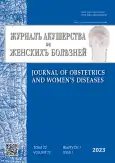The technique of intraoperative bladder filling to prevent surgical injuries of the urinary system during delivery in patients with placenta accrete
- Authors: Kuznetzova N.B.1,2, Barinova V.V.1,2, Bushtyreva I.O.2, Zavarzin P.Z.1,2
-
Affiliations:
- Rostov State Medical University
- Clinic of Professor Bushtyreva Ltd.
- Issue: Vol 72, No 1 (2023)
- Pages: 63-70
- Section: Original study articles
- Submitted: 23.12.2022
- Accepted: 27.01.2023
- Published: 29.03.2023
- URL: https://journals.eco-vector.com/jowd/article/view/119486
- DOI: https://doi.org/10.17816/JOWD119486
- ID: 119486
Cite item
Abstract
BACKGROUND: The annual increase in operative deliveries in obstetrics is steadily leading to an increase in the number of women with placenta accreta spectrum disorders. Cesarean section in patients with placenta accreta spectrum can be done only by surgeons of the highest qualification in operating rooms with the best technical equipment. Every year, the surgical delivery techniques for such patients get better and better, pursuing the goal of preserving the uterus and minimizing intraoperative complications and blood loss.
AIM: The aim of this study was to assess the effectiveness of the intraoperative bladder filling technique during delivery in patients with placenta accreta spectrum.
MATERIALS AND METHODS: All patients were randomly divided into two groups: 22 pregnant women (Group 1) who underwent caesarean section with metroplasty using intraoperative bladder filling technique and 19 pregnant women (Group 2) who underwent caesarean section with metroplasty without bladder filling. We analyzed the course of the operation, the measures taken to prevent blood loss, the time and scope of surgery, as well as surgical complications. Statistical analysis was performed using the non-parametric Mann-Whitney U-test and Fisher’s exact test.
RESULTS: Patients of the both study groups were comparable in age, number of pregnancies in history, number of medical abortions, spontaneous abortions and non-developing pregnancies, as well as in the number of uterine scars in history. The total blood loss was 2177.8 ± 114.9 ml in Group 1 and 2545.7 ± 158.8 ml in Group 2 (p < 0.05). Duration of surgery was 2 hours 45 ± 7.1 minutes in Group 1 and 3 hours 31 ± 4.1 minutes in Group 2. The bladder injury occurred in one patient in Group 1 in three patients in Group 2 (p < 0.05).
CONCLUSIONS: In patients with placenta accreta spectrum, the use of the bladder filling technique and mobilization of the bladder during cesarean section with metroplasty can reduce the percentage of intraoperative complications (incidence of bladder injury), intraoperative blood loss and the duration of surgery.
Full Text
About the authors
Natalia B. Kuznetzova
Rostov State Medical University; Clinic of Professor Bushtyreva Ltd.
Author for correspondence.
Email: lauranb@inbox.ru
ORCID iD: 0000-0002-0342-8745
SPIN-code: 1804-5398
MD, Dr. Sci. (Med), Professor
Russian Federation, Rostov-on-Don; Rostov-on-DonViktoria V. Barinova
Rostov State Medical University; Clinic of Professor Bushtyreva Ltd.
Email: victoria-barinova@yandex.ru
ORCID iD: 0000-0002-8584-7096
SPIN-code: 5068-0680
Scopus Author ID: 57216425249
ResearcherId: AAH-3314-2019
MD, Cand. Sci. (Med.)
Russian Federation, Rostov-on-Don; Rostov-on-DonIrina O. Bushtyreva
Clinic of Professor Bushtyreva Ltd.
Email: kio4@mail.ru
SPIN-code: 5009-1565
MD, Dr. Sci. (Med), Professor
Russian Federation, Rostov-on-DonPyotr Zh. Zavarzin
Rostov State Medical University; Clinic of Professor Bushtyreva Ltd.
Email: zavarzin_pg@rostgmu.ru
SPIN-code: 9256-5662
MD, Cand. Sci. (Med.)
Russian Federation, Rostov-on-Don; Rostov-on-DonReferences
- Silver RM, Landon MB, Rouse DJ. Maternal morbidity associated with multiple repeat cesarean deliveries. Obstet Gynecol. 2006;107(6):1226–1232. doi: 10.1097/01.AOG.0000219750.79480.84
- Özcan HÇ, Balat Ö, Uğur MG. Use of bladder filling to prevent urinary system complications in the management of placenta percreta: a randomized prospective study. Geburtsh Frauenheilk. 2018;78(2):173–178. doi: 10.1055/s-0044-100039
- Aggarwal R, Suneja A, Vaid NB. Morbidly adherent placenta: a critical review. J Obstet Gynaecol India. 2012;62(1):57–61. doi: 10.1007/s13224-012-0149-5
- Bushtyrev V, Barinova V, Umanskiy M, et al. Near miss woman with placenta accreta in Rostov-on-Don regional perinatal centre: “code omega” in action. Glavnyy vrach yuga Rossii. 2017;4(57):52–58. (In Russ.).
- Kulikov IA, Shmakov RG, Belousova TN, et al. Efficacy of the tourniquet hemostasis combined with vaginal balloon tamponade using a Zhukovsky vaginal catheter during delivery in placenta accreta spectrum. Obstetrics and Gynecology. 2022;(10):58–66. (In Russ.). doi: 10.18565/aig.2022.10.58-66
- Zabelina TM, Vasil’chenko ON, Shmakov RG, et al. The effectiveness of complex compression hemostasis in treating different grades of the placenta accreta spectrum disorders. Obstetrics and Gynecology. 2020;(6):30–36. (In Russ.). doi: 10.18565/aig.2020.6.30-36
- Patent RU na izobretenie No. 2626984/ 02.08.2017. Byul. No. 22. Shmakov RG, Chuprynin VD, Vinitskiy AA. Sposob dvukhurovnego gemostaza pri vypolnenii organosokhranyayushchego operativnogo rodorazresheniya u patsientok s vrastaniem platsenty. (In Russ.). [cited 2022 Dec 21]. Available from: https://patents.s3.yandex.net/RU2626984C1_20170802.pdf
- Patent RU na izobretenie No. 2578183/ 20.03.2016. Byul. No. 8. Kurtser MA, Savel’eva GM, Breslav IYu. Sposob konservativnogo khirurgicheskogo lecheniya pri rodorazreshenii patsientok s vrastaniem platsenty. (In Russ). [cited. 2022 Dec 21]. Available from: https://patents.s3.yandex.net/RU2578183C1_20160320.pdf
- Bushtyrev AV, Zamanskaya TA, Bushtyreva IO., et al. Primeneniye trekhmernoy ekhografii s optsiyey energeticheskogo dopplera v diagnostike vrastaniya platsenty. Tavricheskiy mediko-biologicheskiy vestnik. 2016;19(2):33–35. (In Russ.).
- Bushtyrev AV. Prediktsiya i profilaktika akusherskikh krovotecheniy pri anomaliyakh platsentatsii. [dissertation]. Saint Petersburg, 2017. (In Russ.). [cited 21.12.2022]. Available from: https://www.dissercat.com/content/prediktsiya-i-profilaktika-akusherskikh-krovotechenii-pri-anomaliyakh-platsentatsii.
- Matsubara S. “Filling the bladder” at Cesarean hysterectomy for placenta percreta. Geburtshilfe Frauenheilkd. 2018;78(7):715–716. doi: 10.1055/a-0592-5032
- Shmakov RG, Pirogova MM, Vasilchenko ON, et al. Surgery tactics for placenta increta with different depths of invasion. Obstetrics and gynecology. 2020;(1):78–82. (In Russ.). doi: 10.18565/aig.2020.1.78-82
- Tskhay VB, Bakunina AA. Comparative analysis of the effectiveness of different methods of surgical hemostasis in patients with placenta accreta spectrum disorders. Medical Herald of the South of Russia. 2022;13(3):161–172. (In Russ.). doi: 10.21886/2219-8075-2022-13-3-161-172
- Kurtser MA, Normantovich TO, Grigoryan AM, et al. Immediate and long-term results of temporary balloon occlusion of the common iliac arteries in placental ingrowth. Vopr ginekol akus perinatol. 2022;21(1):116–122. (In Russ.). doi: 10.20953/1726-1678-2022-1-116-122
- Kurtser MA, Grigoryan AM, Breslav IYu, et al. Immediate results of temporary balloon occlusion of the common iliac arteries in placenta accreta. Russian Journal of Endovascular Surgery. 2021;8(2):176–184. (In Russ.). doi: 10.24183/2409-4080-2021-8-2-176-184
- Barinov SV, Shmakov RG, Medyannikova IV, et al. Efficacy of distal haemostasis during caesarean delivery in women with placenta accreta spectrum disorders. J Matern Fetal Neonatal Med. 2022;35(25):8778–8785. doi: 10.1080/14767058.2021.2005019
Supplementary files









